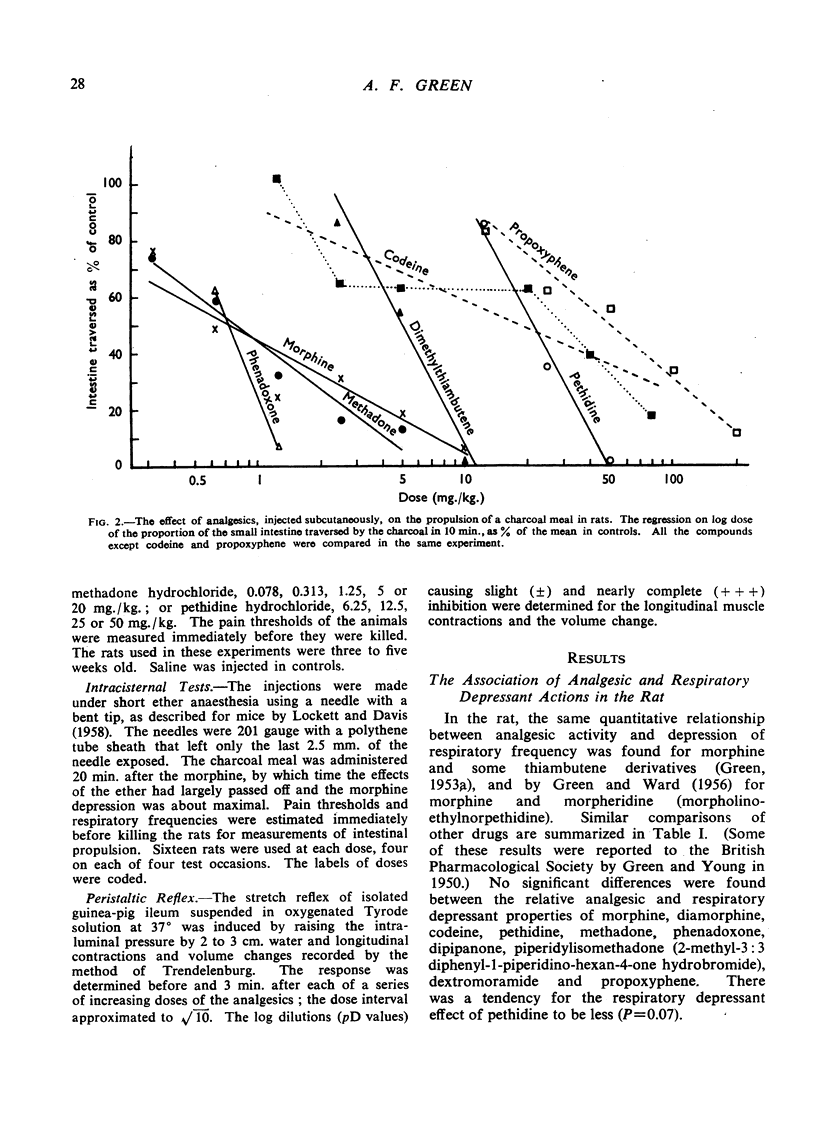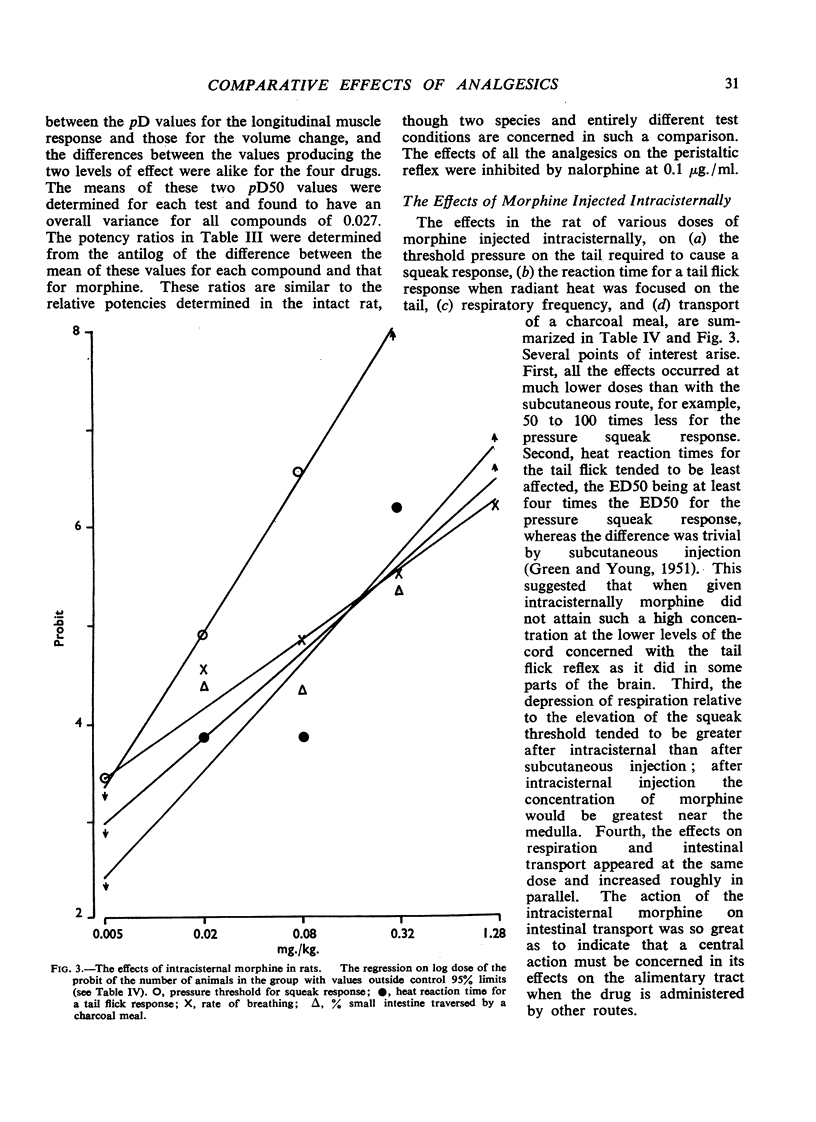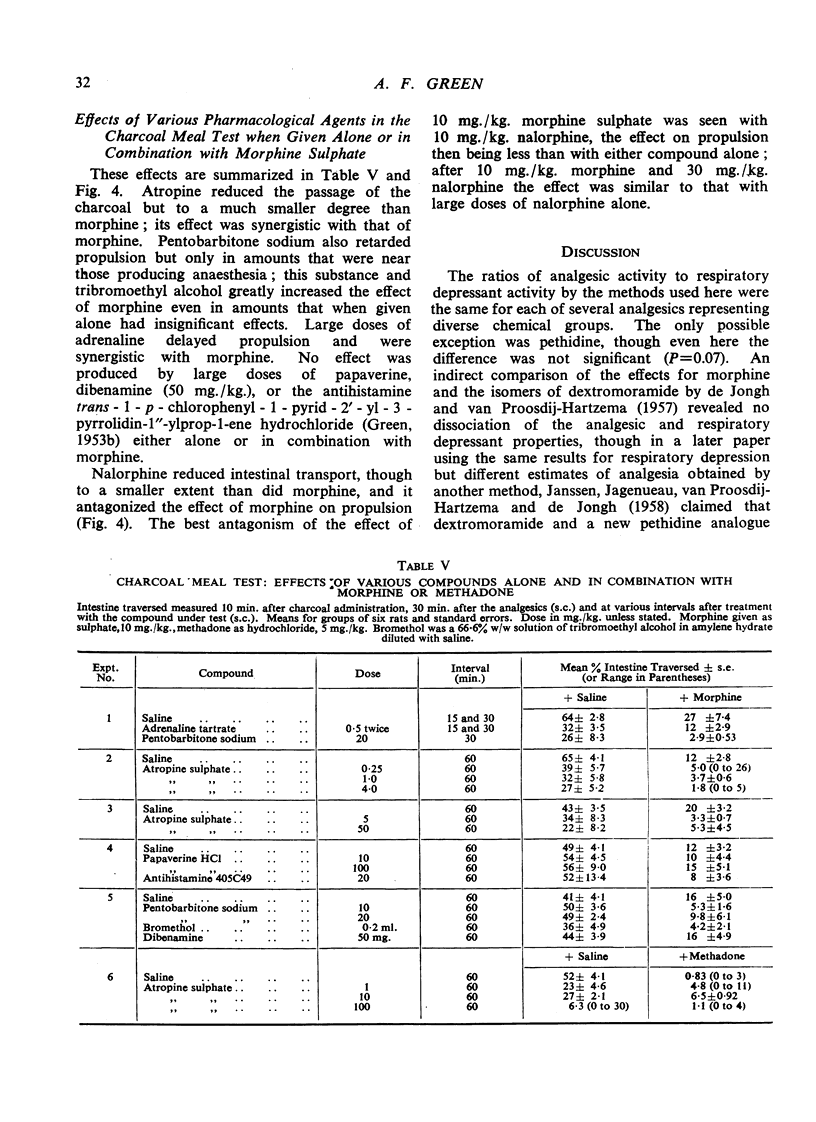Abstract
In the rat, the ratio of the analgesic to the respiratory depressant potency was the same for morphine, codeine, diamorphine, methadone, dipipanone, piperidylisomethadone, phenadoxone, dextromoramide, and propoxyphene. The relative respiratory depressant activity of pethidine tended to be less, but the difference was not significant. The ratio of the analgesic dose to the dose preventing transport of a charcoal meal in the rat was about the same for morphine, codeine, pethidine, methadone, phenadoxone, dimethylthiambutene, and propoxyphene; the relative activities of these compounds in inhibiting the peristaltic reflex of the isolated guinea-pig ileum were also similar. However, because of differences in the slopes of regression lines in the charcoal meal test, some compounds (for example, morphine) had a greater effect on gastrointestinal propulsion than others (for example, pethidine) when given at moderate analgesic dose levels.
In studies of the effects of intracisternal morphine in the rat, effects on the spinal reflex of the tail were to some extent dissociated from effects on the threshold for a squeak response. Further, the delaying of transport of a charcoal meal paralleled depression of respiratory rate, and this is evidence for the participation of a central as well as a peripheral action in the effect of morphine on the gastrointestinal tract. The delay in propulsion was reduced by nalorphine and increased by atropine and two general anaesthetic substances, but was unaffected by a number of other pharmacological agents.
Full text
PDF








Selected References
These references are in PubMed. This may not be the complete list of references from this article.
- DE JONGH D. K., VAN PROOSDIJ-HARTZEMA E. G. Pharmacology of (+)-, (+)-and (-)-2:2-diphenyl-3-methyl-4-morpholino-butyrylpyrrolidine. J Pharm Pharmacol. 1957 Nov;9(11):730–738. doi: 10.1111/j.2042-7158.1957.tb12331.x. [DOI] [PubMed] [Google Scholar]
- JANSSEN P. A., JAGENEAU A. H. A new series of potent analgesics: dextro 2:2-diphenyl-3-methyl-4-morpholino-butyrylpyrrolidine and related amides. I. Chemical structure and pharmacological activity. J Pharm Pharmacol. 1957 Jun;9(6):381–400. [PubMed] [Google Scholar]
- JANSSEN P. A., JAGENEAU A. H., VAN PROOSDIJ-HARTZEMA E. G., DE JONGH D. K. The pharmacology of a new potent analgesic, R 951 2-[N-(4-carbethoxy-4-phenyl)-piperidino]-propiophenone HCI. Acta Physiol Pharmacol Neerl. 1958 Jul;7(3):373–402. [PubMed] [Google Scholar]
- LOCKETT M. F., DAVIS M. M. The analgesic action of normorphine administered intracisternally to mice. J Pharm Pharmacol. 1958 Feb;10(2):80–85. doi: 10.1111/j.2042-7158.1958.tb10276.x. [DOI] [PubMed] [Google Scholar]
- ROBBINS E. B. The pharmacologic effects of a new analgesic alpha-4-dimethylamino-1,2-diphenyl-3-methyl-4-propionyloxybutane. J Am Pharm Assoc Am Pharm Assoc. 1955 Aug;44(8):497–500. doi: 10.1002/jps.3030440812. [DOI] [PubMed] [Google Scholar]
- SCHAUMANN O., GIOVANNINI M., JOCHUM K. Morphinähnlich wirkende Analgetika und Darmmotorik. I. Spasmolyse und Peristaltik. Naunyn Schmiedebergs Arch Exp Pathol Pharmakol. 1952;215(5-6):460–468. [PubMed] [Google Scholar]
- SCHAUMANN W. Zur Wirkung der morphinähnlich wirkenden Analgetica auf den Meerschweinchendünndarm in situ. Naunyn Schmiedebergs Arch Exp Pathol Pharmakol. 1954;223(4):348–354. [PubMed] [Google Scholar]
- WILLAMS E. M. V., STREETEN D. H. P. The action of morphine, pethidine, and amidone upon the intestinal motility of conscious dogs. Br J Pharmacol Chemother. 1950 Dec;5(4):584–603. doi: 10.1111/j.1476-5381.1950.tb00609.x. [DOI] [PMC free article] [PubMed] [Google Scholar]


